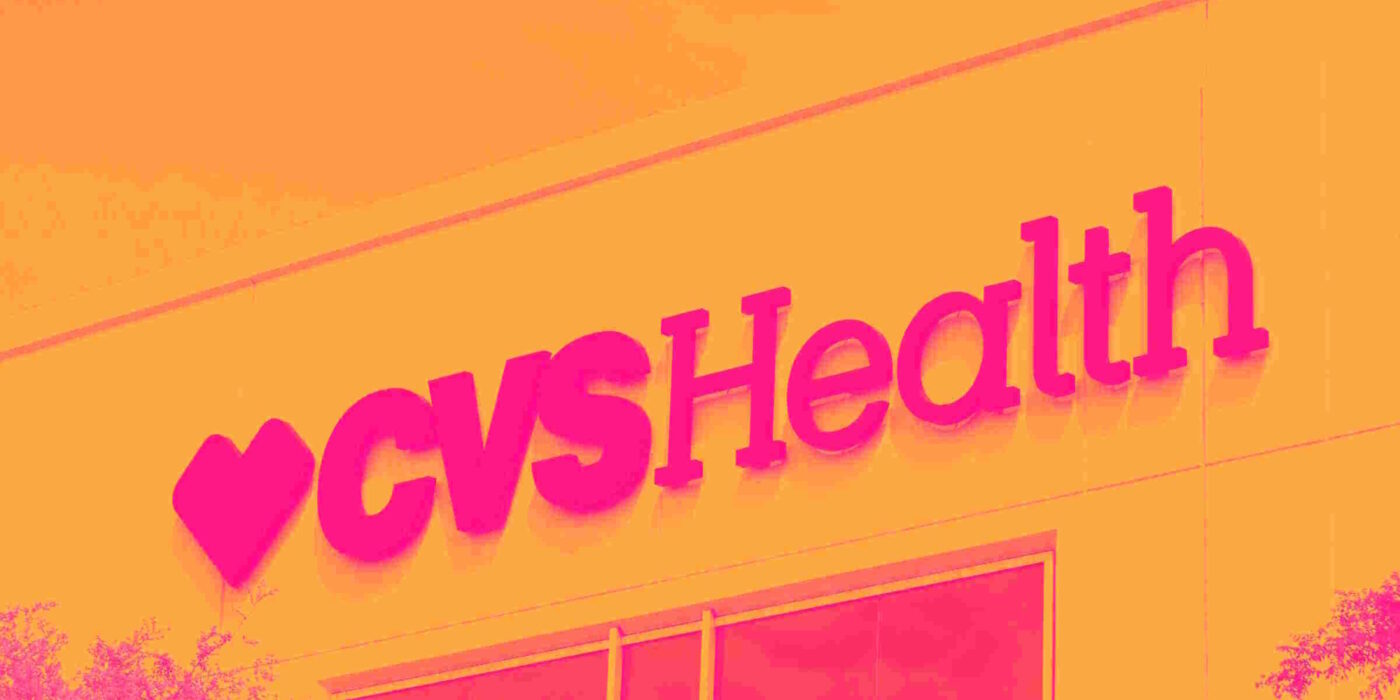
Diversified healthcare company CVS Health (NYSE: CVS) beat Wall Street’s revenue expectations in Q1 CY2025, with sales up 7% year on year to $94.59 billion. Its non-GAAP profit of $2.25 per share was 34.6% above analysts’ consensus estimates.
Is now the time to buy CVS Health? Find out by accessing our full research report, it’s free.
CVS Health (CVS) Q1 CY2025 Highlights:
- Revenue: $94.59 billion vs analyst estimates of $93.18 billion (7% year-on-year growth, 1.5% beat)
- Adjusted EPS: $2.25 vs analyst estimates of $1.67 (34.6% beat)
- Adjusted EBITDA: $4.65 billion vs analyst estimates of $4.29 billion (4.9% margin, 8.5% beat)
- Management raised its full-year Adjusted EPS guidance to $6.10 at the midpoint, a 3.8% increase
- Operating Margin: 3.6%, in line with the same quarter last year
- Free Cash Flow Margin: 4%, similar to the same quarter last year
- Same-Store Sales rose 14.2% year on year (5.3% in the same quarter last year)
- Market Capitalization: $84.21 billion
Company Overview
With over 9,000 retail pharmacy locations serving as neighborhood health destinations across America, CVS Health (NYSE: CVS) operates retail pharmacies, provides pharmacy benefit management services, and offers health insurance through its Aetna subsidiary.
Sales Growth
Reviewing a company’s long-term sales performance reveals insights into its quality. Even a bad business can shine for one or two quarters, but a top-tier one grows for years. Luckily, CVS Health’s sales grew at a decent 7.7% compounded annual growth rate over the last five years. Its growth was slightly above the average healthcare company and shows its offerings resonate with customers.
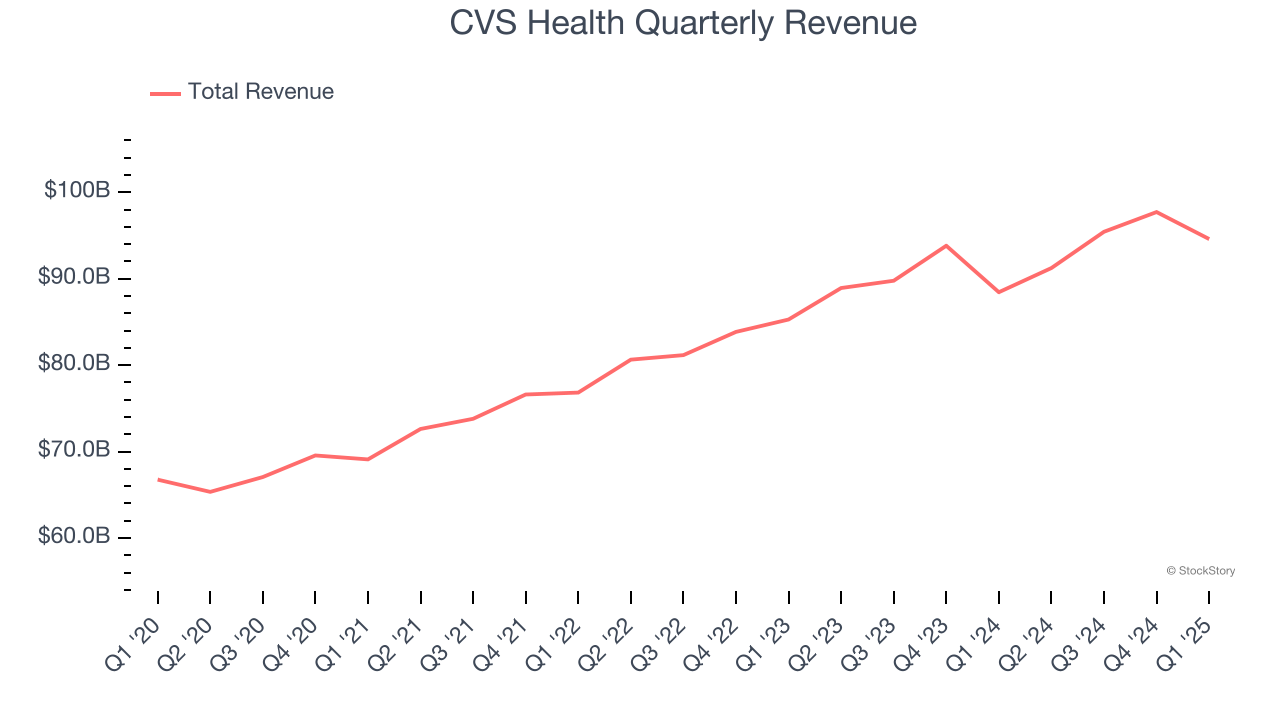
Long-term growth is the most important, but within healthcare, a half-decade historical view may miss new innovations or demand cycles. CVS Health’s annualized revenue growth of 7% over the last two years aligns with its five-year trend, suggesting its demand was consistently weak. 
CVS Health also reports same-store sales, which show how much revenue its established locations generate. Over the last two years, CVS Health’s same-store sales averaged 10.3% year-on-year growth. Because this number is better than its revenue growth, we can see its sales from existing locations are performing better than its sales from new locations. 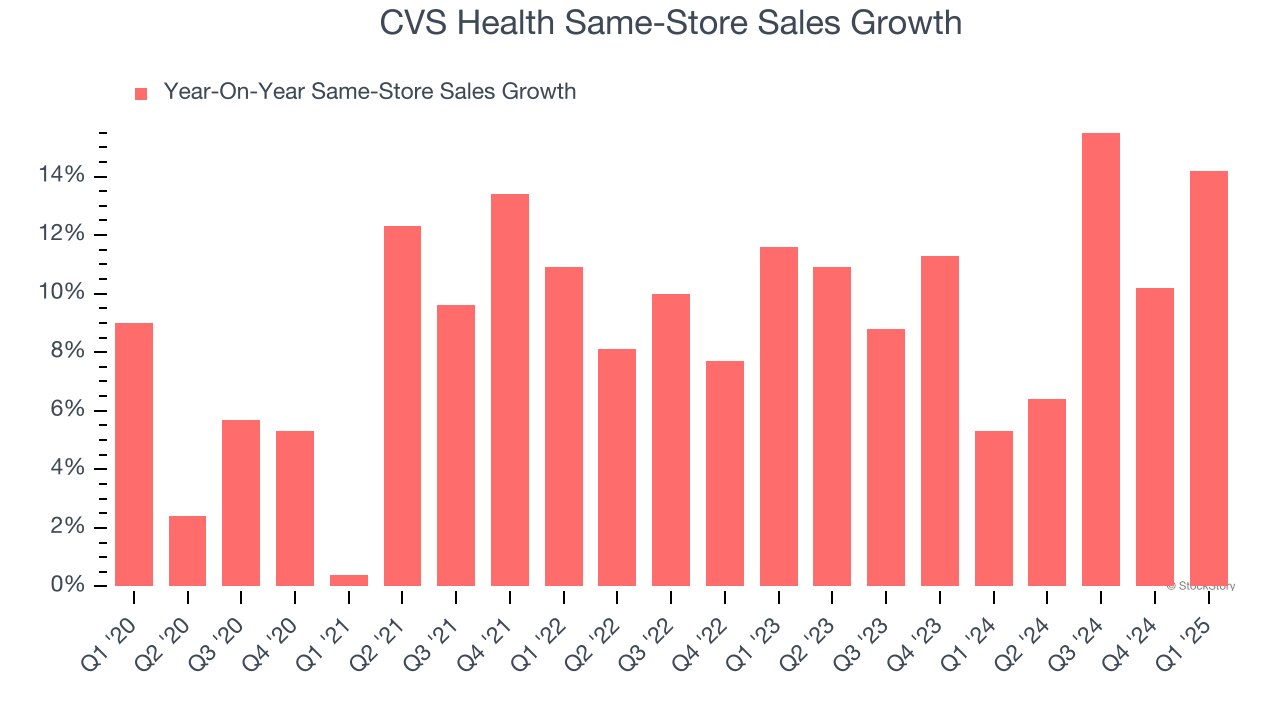
This quarter, CVS Health reported year-on-year revenue growth of 7%, and its $94.59 billion of revenue exceeded Wall Street’s estimates by 1.5%.
Looking ahead, sell-side analysts expect revenue to grow 3.7% over the next 12 months, a deceleration versus the last two years. This projection doesn't excite us and implies its products and services will see some demand headwinds.
Software is eating the world and there is virtually no industry left that has been untouched by it. That drives increasing demand for tools helping software developers do their jobs, whether it be monitoring critical cloud infrastructure, integrating audio and video functionality, or ensuring smooth content streaming. Click here to access a free report on our 3 favorite stocks to play this generational megatrend.
Adjusted Operating Margin
Adjusted operating margin is one of the best measures of profitability because it tells us how much money a company takes home after subtracting all core expenses, like marketing and R&D. It also removes various one-time costs to paint a better picture of normalized profits.
CVS Health was profitable over the last five years but held back by its large cost base. Its average adjusted operating margin of 5% was weak for a healthcare business.
Analyzing the trend in its profitability, CVS Health’s adjusted operating margin decreased by 2.4 percentage points over the last five years. The company’s two-year trajectory also shows it failed to get its profitability back to the peak as its margin fell by 1.8 percentage points. This performance was poor no matter how you look at it - it shows its expenses were rising and it couldn’t pass those costs onto its customers.
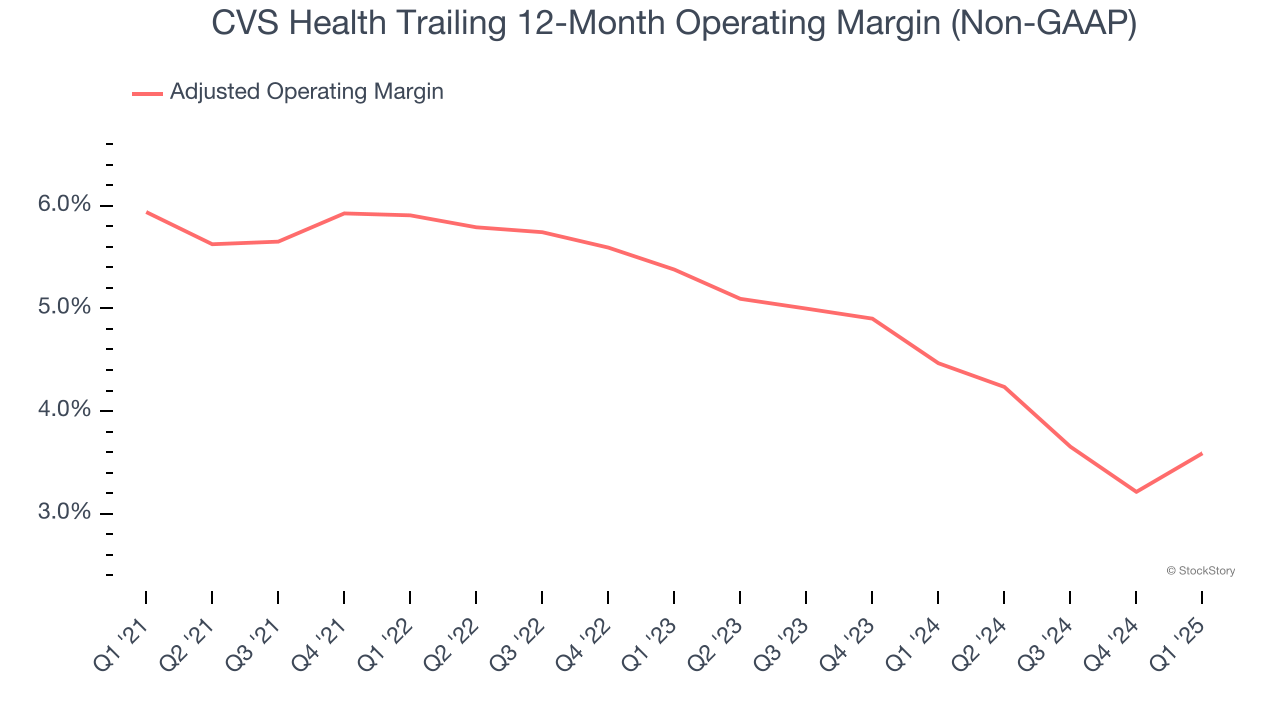
This quarter, CVS Health generated an adjusted operating profit margin of 4.8%, up 1.5 percentage points year on year. This increase was a welcome development and shows it was more efficient.
Earnings Per Share
Revenue trends explain a company’s historical growth, but the long-term change in earnings per share (EPS) points to the profitability of that growth – for example, a company could inflate its sales through excessive spending on advertising and promotions.
Sadly for CVS Health, its EPS declined by 2.9% annually over the last five years while its revenue grew by 7.7%. This tells us the company became less profitable on a per-share basis as it expanded due to non-fundamental factors such as interest expenses and taxes.
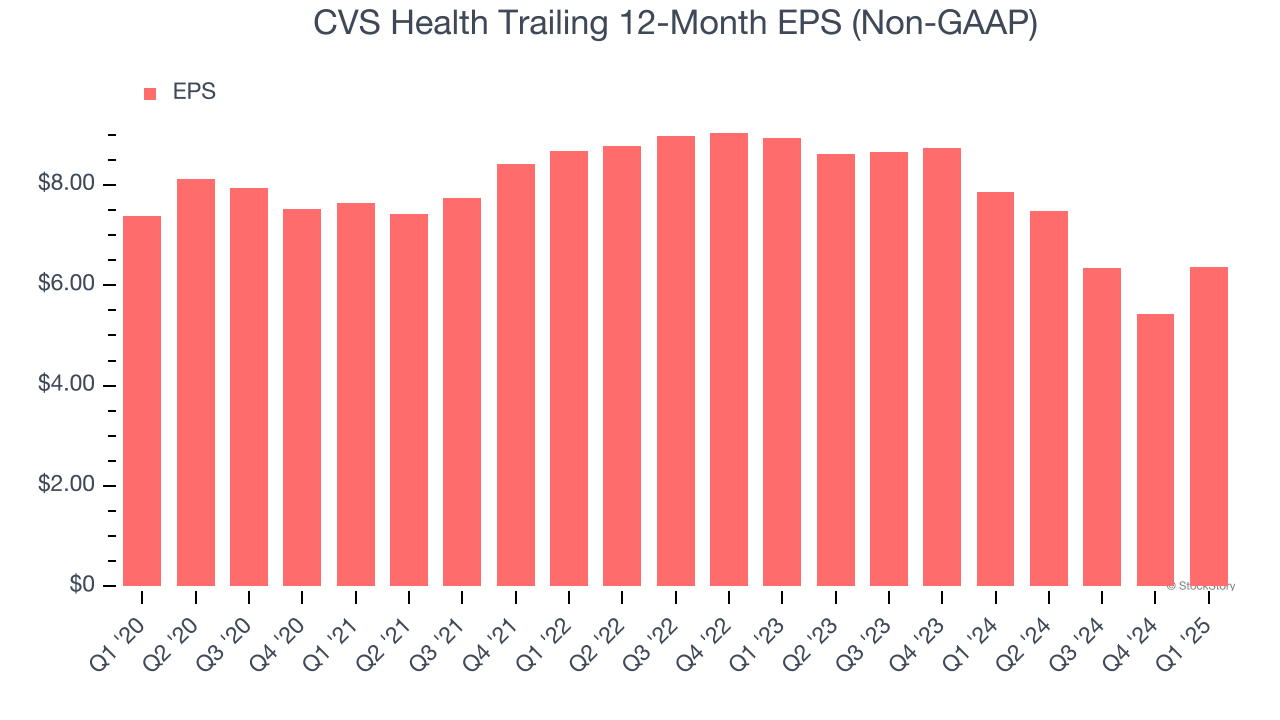
We can take a deeper look into CVS Health’s earnings to better understand the drivers of its performance. As we mentioned earlier, CVS Health’s adjusted operating margin improved this quarter but declined by 2.4 percentage points over the last five years. This was the most relevant factor (aside from the revenue impact) behind its lower earnings; taxes and interest expenses can also affect EPS but don’t tell us as much about a company’s fundamentals.
In Q1, CVS Health reported EPS at $2.25, up from $1.31 in the same quarter last year. This print easily cleared analysts’ estimates, and shareholders should be content with the results. Over the next 12 months, Wall Street expects CVS Health’s full-year EPS of $6.36 to shrink by 3.1%.
Key Takeaways from CVS Health’s Q1 Results
This was a 'beat and raise' quarter. We were impressed by how significantly CVS Health blew past analysts’ same-store sales expectations this quarter. We were also excited its EPS outperformed Wall Street’s estimates by a wide margin. Looking ahead, the company raised its full-year EPS guidance. Zooming out, we think this quarter featured some important positives. The stock traded up 8.9% to $72.61 immediately after reporting.
Sure, CVS Health had a solid quarter, but if we look at the bigger picture, is this stock a buy? We think that the latest quarter is only one piece of the longer-term business quality puzzle. Quality, when combined with valuation, can help determine if the stock is a buy. We cover that in our actionable full research report which you can read here, it’s free.





